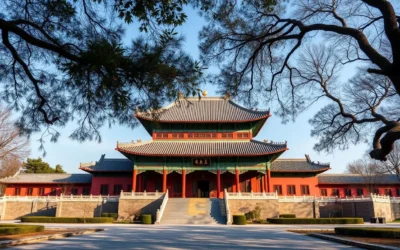✓ Accommodations✓ Flights✓ Rental Cars
Shandong Province is a cultural and linguistic hub in the People’s Republic of China. With a population of over 101 million, it is home to a rich tapestry of history and traditions. This region has played a pivotal role in shaping the nation’s identity, blending ancient influences with modern progress.
Mandarin, the official language, is widely used here, reflecting its importance in education and daily life. However, the area also boasts a variety of regional dialects that add depth to its linguistic landscape. These dialects are a testament to the province’s diverse heritage and the resilience of its people.
Over time, Shandong has become a symbol of cultural pride. Its history is intertwined with the evolution of language, from ancient scripts to contemporary policies. Exploring this region offers a unique glimpse into how language shapes identity and community.
In this article, you’ll discover the fascinating interplay between heritage and modernity. From personal stories to scholarly insights, we’ll uncover the heart of Shandong’s linguistic legacy.
Historical Overview and Linguistic Heritage
The rich history of this region is deeply tied to its linguistic evolution. From the Shang dynasty to the Qing dynasty, each era left its mark on the cultural and linguistic landscape. The Yellow River, a vital geographical landmark, played a key role in shaping this heritage.

Ancient Dynasties and Cultural Foundations
During the Shang dynasty, early forms of language began to emerge. The Zhou dynasty, particularly the Western and Eastern Zhou periods, saw the rise of states like Qi and Lu. These states became cultural hubs, fostering traditions that influenced the region’s language.
The Spring and Autumn period was a time of dynamic change. Philosophical ideas flourished, and temples became centers for preserving ancient traditions. This era laid the groundwork for the region’s unique linguistic identity.
The Legacy of Confucius and Other Philosophers
Confucius, born in Qufu, left an indelible mark on the region. His teachings shaped educational traditions and language use. Temples dedicated to him became symbols of cultural pride.
His disciples further spread his ideas, ensuring their influence endured through centuries. The Qing dynasty later adopted reforms that integrated these traditions into modern practices.
| Dynasty | Key Contributions |
|---|---|
| Shang Dynasty | Early language development |
| Zhou Dynasty | Rise of Qi and Lu states |
| Spring and Autumn Period | Philosophical and linguistic growth |
| Qing Dynasty | Integration of traditions |
This region’s history is a testament to the enduring power of language. From ancient scripts to modern reforms, every dynasty contributed to its rich heritage.
Geography and Cultural Sites in Shandong
From towering peaks to ancient cities, this area offers a unique cultural experience. The region’s geography is a blend of majestic landscapes and historic landmarks. Each place tells a story of tradition and pride.
Mount Tai and Sacred Temples
Mount Tai, standing at 5,069 feet, is a symbol of spiritual and natural power. This mountain has been a site of worship for centuries. Its sacred temples attract pilgrims from all over northern China.
The temples here are not just places of worship but also historical treasures. They reflect the region’s deep connection to its cultural roots. “Climbing Mount Tai is like stepping into history,” says a local guide.
Notable Cities and Landmarks
Qingdao, a coastal city, is famous for its beer legacy and scenic beauty. Jinan, known as the “City of Springs,” boasts natural springs and historic sites. Qufu, the birthplace of Confucius, is a cultural gem.
The Yellow River flows through this area, shaping its geography and culture. The sea along the coastline adds to the region’s charm. These features have influenced local traditions and language expression.
| Landmark | Significance |
|---|---|
| Mount Tai | Spiritual and natural symbol |
| Qingdao | Beer legacy and coastal beauty |
| Jinan | City of Springs |
| Qufu | Birthplace of Confucius |
These cultural sites are reflections of longstanding traditions. They showcase the region’s pride and heritage. Whether you’re exploring mountains or cities, this place offers something unforgettable.
Shandong Province, China: Official and Widely Spoken Languages
Language plays a pivotal role in shaping identity and culture in this region. Standard Mandarin serves as the official language, used in education, media, and government. Its widespread adoption reflects national unity and modern communication needs.

However, regional dialects add a unique flavor to everyday life. These variations in pronunciation and vocabulary showcase the area’s rich heritage. For example, the Zhongyuan dialect differs significantly from Standard Mandarin, preserving historical influences.
Dialects are more than just words; they are a way to express family and community ties. “Speaking our dialect feels like keeping our traditions alive,” says a local resident. This connection to heritage is deeply rooted in daily interactions.
Modern education policies promote the use of pinyin to standardize pronunciation. Yet, dialect differences persist, reflecting both historical roots and personal identity. This balance between tradition and modernity is a hallmark of the region’s linguistic landscape.
Exploring these dialects offers a glimpse into the area’s cultural depth. Whether you’re learning Mandarin or listening to a local conversation, you’ll discover how language shapes identity and connection.
Regional Dialects and Pronunciation Variations
The Zhongyuan dialect offers a unique glimpse into the linguistic diversity of northern regions. As part of the Mandarin family, it reflects the rich heritage of the area. This dialect is more than just a way of speaking; it’s a bridge to the past and a marker of identity.

Understanding Zhongyuan Dialects
One of the most notable features of the Zhongyuan dialect is its pronunciation variations. Compared to Standard Mandarin, it often shifts tones and sounds. For example, the /θ/ sound might be pronounced as /s/, a common trait noted in recordings.
These differences aren’t random. They stem from historical influences and local customs. “Our dialect connects us to our ancestors,” says a local from Heze. This connection is deeply rooted in daily life and family traditions.
Educational policies also play a role. While pinyin is taught to standardize pronunciation, regional dialects persist. This balance between tradition and modernity is a hallmark of the area’s linguistic landscape.
Here’s a quick comparison of key pronunciation traits:
| Feature | Standard Mandarin | Zhongyuan Dialect |
|---|---|---|
| /θ/ Sound | Pronounced as /θ/ | Pronounced as /s/ |
| Tone Shifts | Consistent tones | Varied tones |
| Vocabulary | Standard terms | Local expressions |
The Zhongyuan dialect is a testament to the enduring power of language. It preserves Han Chinese identity and group heritage, offering a rich cultural tapestry. To learn more about the diversity of Chinese dialects, explore Varieties of Chinese.
Understanding these variations helps you appreciate the region’s linguistic depth. Whether you’re learning Mandarin or listening to a local conversation, you’ll discover how language shapes identity and connection. For further insights into Mandarin’s role, visit Mandarin Chinese.
Modern Influences on Language and Education
Modern education reforms have reshaped the linguistic landscape, blending tradition with global influence. Over the years, these changes have introduced new opportunities for learning and cultural exchange. Today, the focus is on balancing local heritage with the demands of a connected world.

English Learning and Global Interactions
English has become a key part of education, with over 400 million learners nationwide. This growth reflects the country’s push to engage globally. Programs like the College English Test (CET-4) ensure students meet proficiency standards, though reforms are gradually reducing its weight in exams.
Exchange programs and international collaborations further boost English skills. For example, the Beijing New Oriental School has grown to serve 800,000 students across 20 cities. These efforts highlight the importance of English in education and career development.
Educational Policies and Language Development
Recent policies emphasize Mandarin while integrating foreign language instruction. Since the 1980s, English has been a compulsory subject in schools. This approach fosters unity while preparing students for global opportunities.
Yearly updates to curricula ensure relevance in a changing world. For instance, the National Matriculation English Test (NMET) is evolving to reflect modern needs. These reforms aim to preserve local dialects while embracing global trends.
For more insights into how dialects influence language learning, explore this study on regional impacts. Additionally, learn about the broader context of language coexistence in this comprehensive guide.
Personal Stories and Biographical Insights from Shandong
Personal narratives offer a unique window into the cultural fabric of this area. Each story reveals how language shapes identity, connecting individuals to their roots. For many, the way they speak is a reflection of their family, traditions, and community ties.
Take the story of a 21-year-old man from Heze. Growing up in a city with a population of over 9 million, he experienced the blend of local dialects and Mandarin daily. “At home, we speak our dialect, but in school, it’s all Mandarin,” he shares. This duality is common in the region, where dialects persist despite the dominance of the official language.
A Glimpse into Local Life and Accents
Early language learning often begins at home. For this young man, his first words were in the local dialect, a tradition passed down through generations. His family’s pronunciation differs slightly from Standard Mandarin, a trait shared by many in his group.
City life also plays a role. In Heze, the mix of urban development and rural traditions creates a unique linguistic environment. “Our accent changes depending on who we’re talking to,” he explains. This adaptability reflects the region’s rich heritage and modern influences.
Historical events have left their mark too. The Cultural Revolution disrupted education for many, but today’s youth are embracing new opportunities. Learning English, for example, has become a priority. “It’s not just about communication; it’s about connecting with the world,” he says.
These stories highlight the human side of linguistic development. Whether it’s the way a person speaks or the traditions they uphold, language remains a powerful force in shaping identity. For more on how cultural heritage influences identity, explore the exploration of identity by Gish Jen.
Conclusion
This region stands as a testament to the enduring power of language and culture. From ancient dynasties to modern education, its legacy continues to shape identity and connection. The blend of historical sites, regional dialects, and global influences creates a unique tapestry that defines this place.
With a population of over 101 million, the area’s cultural impact is immense. Its linguistic diversity, from Mandarin to local dialects, reflects a rich heritage. Modern reforms have further integrated global trends, making it a vital part of the country’s progress.
Whether exploring ancient temples or engaging with modern education, this region offers a glimpse into the world’s cultural evolution. Its story is one of resilience and pride, setting an example for the world to follow. Discover more about its history here.
In the end, this area’s linguistic and cultural heritage remains a cornerstone of its identity. It invites you to appreciate the range of traditions that continue to thrive. Explore how language shapes communities and connects people across borders.
The above is subject to change.
Check back often to TRAVEL.COM for the latest travel tips and deals.






